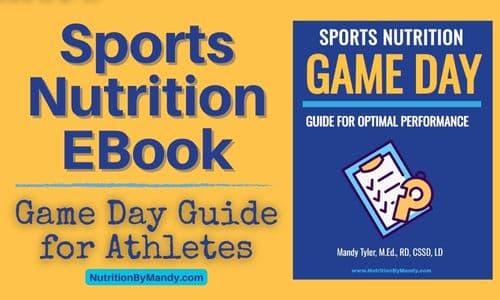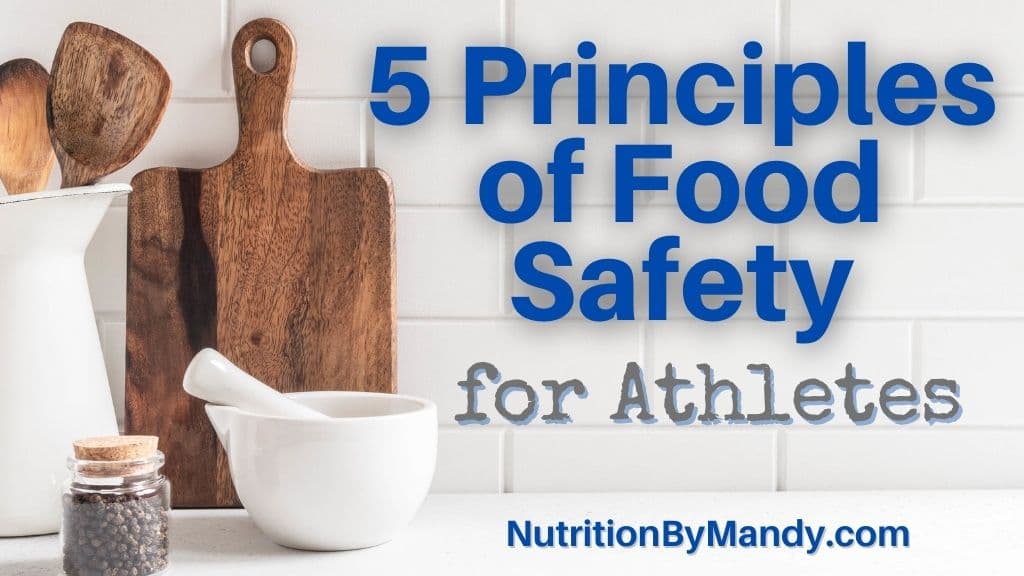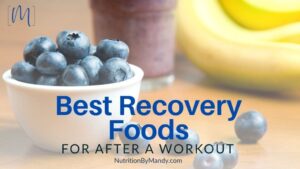Last Updated on November 21, 2025 by Mandy Tyler, M.Ed., RD, CSSD, LD
5 Principles of Food Safety for Athletes
*This article includes affiliate links. As an Amazon Associate, I earn from qualifying purchases.
It is helpful for athletes to know steps they can take to reduce the risk of getting a foodborne illness. Even with busy schedules and multiple priorities, making time for food safety is important.
Below are five principles of food safety that athletes can follow to minimize food safety risks.
Food Safety Principle #1: Wash Your Hands
The first principle of food safety is handwashing.
To ensure you are getting your hands clean, scrub your hands using soap and warm water for 20 seconds. Make sure to scrub all surfaces of your hands, including under your nails.
This can seem like a long time when you are washing your hands. To help gauge the time, sing the “Happy Birthday” song to yourself twice.
After you are done, rinse your hands thoroughly in warm water and dry using a single-use paper towel.

When to Wash Your Hands
Athletes should make sure to wash their hands frequently throughout the day.
In the kitchen, athletes should wash their hands at the following times (1):
- Before and after eating
- Before preparing food
- Between food preparation tasks in the kitchen
- After handling raw food (i.e., raw beef, pork, poultry, seafood)
- After touching your face, blowing your nose, or sneezing
- After handling garbage
Are Hand Sanitizers Effective?
When soap and water are not available, the Centers for Disease Control and Prevention recommends using an alcohol-based hand sanitizer. Athletes should choose a hand sanitizer that contains at least 60% alcohol.
To apply the hand sanitizer, squeeze the gel in the palm of your hands and rub it all over your hands and fingers. Continue rubbing your hands together until they are dry.
Dietitian’s Pick: The Touchland® hand sanitizing mists (available on Amazon) are a convenient option for athletes. Their hand sanitizing mists contain 70% alcohol, aloe vera, as well as essential oils. They come in a travel size container, which is perfect for athletes to keep in their lunch box or gym bag.
Handwashing vs. Hand Sanitizers
Keep in mind that while hand sanitizers can help kill bacteria, it will not remove dirt, debris, or all the germs from your hands.
If a sink is available, washing your hands with soap and running water is the best option.
Food Safety for Team Meals
When planning team meals, make sure to keep handwashing in mind. If athletes will not have access to soap and water to wash their hands, have hand sanitizer available.
I encourage teams to place a container of hand sanitizer in the food service area and also have it available on the bus.

Food Safety Principle #2: Keep it Clean
The next principle of food safety for athletes to focus on is keeping the kitchen clean. This includes cleaning counters, cutting boards, knives, and other cooking utensils.
In addition, it applies to cleaning fresh produce prior to eating or using in a recipe.
Clean the Counters
Keeping the kitchen clean as food is prepared is important. Athletes should take time to clean the kitchen counters with hot, soapy water prior to preparing food (2).
Then, between each food preparation task in the kitchen, clean the counters, cutting board, knives, and any other utensils used.
Cleaning Fresh Produce
Before eating fresh fruits and vegetables or chopping them to use in a recipe, it is important to wash the produce. Fresh fruits and vegetables are grown in fields, on vines, on trees, and in the ground. Thus, they are exposed to dirt, insects, animals, and the weather.
The produce is then harvested and transported, sometimes many miles, before it ends up at the store where you buy it.
Pro Tip: Regardless of whether the produce is organic or not, athletes need to wash fresh produce before consuming it.
How to Wash Fresh Produce
To wash produce, hold it under running water and gently rub the produce to remove any exterior dirt.
If the produce has a firm outer skin, you can use a clean scrub brush to gently scrub the produce (3). This works well with produce such as cucumbers, squash, and melons.
For produce you plan to slice before eating, such as watermelon or cantaloupe, the exterior still needs to be washed before cutting. This prevents dirt from the outside of the produce from being transferred onto the knife, cutting board, and ultimately the produce you plan to eat.
Food Safety Principle #3: Avoid Cross-Contamination
When preparing food in the kitchen, a key food safety principle is avoiding cross-contamination. Cross-contamination occurs when bacteria from one food transfers onto another.
Cross-contamination is particularly a concern when preparing raw meat, pork, poultry, or seafood.
It is important to take steps to ensure the bacteria from the raw proteins does not get transferred onto other foods you are preparing to eat.
Steps to Prevent Cross-Contamination in the Kitchen
There are several steps athletes can take to prevent cross-contamination from occurring (2):
- Keep foods that are ready to eat, such as fresh produce, separate from those that require cooking, such as meat, fish, and poultry.
- Wash your hands between all meal preparation tasks in the kitchen and especially after handling any type of raw protein.
- Use separate cutting boards in the kitchen for raw proteins.
- Wash and sanitize the knife, cutting board, and counter between each food item you prepare.

Food Safety Principle #4: Temperature Control
Another key principle of food safety is temperature control. It is necessary to cook foods to the appropriate internal temperatures to kill harmful bacteria.
The USDA’s Safe Minimum Internal Temperature Chart is a great resource to keep handy. Use this chart as a guide to ensure foods are cooked to the necessary internal temperature. It is important to use a food thermometer to measure the internal temperature of food and not just guess that the item is done cooking.
Dietitian’s Pick: The ThermoPro® Digital Thermometer is a helpful kitchen device that I recommend athletes keep on hand. The thermometer quickly measures the internal temperature of food cooking in the oven or on the grill. It is also waterproof, which allows for easy clean-up after cooking.
Hold Food at the Appropriate Temperatures
In addition to cooking, it is important to hold food at the appropriate temperature.
The Centers for Disease Control and Prevention defines the temperature range between 40°F and 140°F, as the “Danger Zone” in which bacteria can rapidly grow.
When food is left sitting out, we want to hold food outside of the temperature “Danger Zone.” This means hot food should be held above 140°F and cold food below 40°F to help prevent bacterial growth.
Foods should not be left sitting out in the temperature danger zone for more than 2 hours. This time frame decreases to 1 hour if the temperature exceeds 90°F, such as at a track meet or baseball game.
Dispose of Food Left Sitting in the Temperature Danger Zone
Consuming food that has been left in the temperature danger zone over the recommended time limits increases one’s risk of getting a foodborne illness.
Any food items that are held without temperature control for over these time limits should be thrown away. As a reminder, this applies to all perishable foods, including those commonly left sitting out, such as pizza or deli trays.
Food Safety for Team Dinners
When planning team dinners, it is important for the food be held at the appropriate temperatures to prevent the risk of foodborne illnesses.
When arranging the meal, make sure to consider how the food will be held hot or cold prior to service.

Food Safety Principle #5: Leftovers
The final food safety principle for athletes to be aware of is the handling of leftover food items.
As discussed above, leftover food items need to be stored in the refrigerator or freezer within 2 hours. This applies to leftover food items brought home from restaurants as well.
Athletes need to make it a priority to clean out their refrigerators on a regular basis and get rid of leftover food. Generally, after 3-4 days in the refrigerator, leftovers should be thrown away to prevent the possibility of getting a foodborne illness (4).
Pro Tip: When athletes are traveling, they should be mindful about how they store leftover food items in their hotel room. If athletes do not have access to a refrigerator, they should not save the leftovers to eat later.

5 Principles of Food Safety for Athletes
You are now set with 5 easy steps athletes can take to help reduce their risk of getting a foodborne illness.
Following these basic principles can help decrease the risk of food safety concerns when preparing and storing food.
For additional sports nutrition tips for athletes, check out my blog: Meal Prep for Athletes.
Join the Nutrition By Mandy Email List & Get a Free Weekly Meal Planner Template
Click HERE to join the Nutrition By Mandy e-mail list. When you join you will receive a free weekly meal planner template to download and plan out your meals for the week.
About the Author
Mandy Tyler is a Sports Dietitian Nutritionist in the San Antonio, TX area. She is a Registered and Licensed Dietitian, a Board-Certified Specialist in Sports Dietetics, a Licensed Athletic Trainer, and is a Certified Exercise Physiologist through the American College of Sports Medicine. Mandy has experience working with athletes at the high school, collegiate, and professional levels. She believes the key to reaching one’s full potential, both in everyday life and in sports performance, relies on a healthy nutritional foundation.

If you are looking to take your performance to the next level, make sure to check out my new Sports Nutrition Game Day Guide. This downloadable guide is written to help athletes develop an individualized plan to achieve peak performance on game day.





